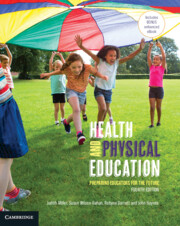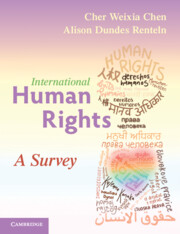Refine search
Actions for selected content:
36846 results in Cambridge Textbooks
Acknowledgments
-
- Book:
- Health and Physical Education
- Published online:
- 12 August 2022
- Print publication:
- 16 August 2022, pp xviii-xix
-
- Chapter
- Export citation
1 - The health and physical education continuum from early childhood to secondary school
-
-
- Book:
- Health and Physical Education
- Published online:
- 12 August 2022
- Print publication:
- 16 August 2022, pp 7-19
-
- Chapter
- Export citation
5 - Contemporary approaches to health education and health promotion
-
-
- Book:
- Health and Physical Education
- Published online:
- 12 August 2022
- Print publication:
- 16 August 2022, pp 87-124
-
- Chapter
- Export citation
7 - Teaching inclusively: Equity and diversity in education
-
-
- Book:
- Health and Physical Education
- Published online:
- 12 August 2022
- Print publication:
- 16 August 2022, pp 152-174
-
- Chapter
- Export citation
3 - The foundation of movement skills
-
-
- Book:
- Health and Physical Education
- Published online:
- 12 August 2022
- Print publication:
- 16 August 2022, pp 35-63
-
- Chapter
- Export citation
About the authors
-
- Book:
- Health and Physical Education
- Published online:
- 12 August 2022
- Print publication:
- 16 August 2022, pp xvi-xvii
-
- Chapter
- Export citation

Health and Physical Education
- Preparing Educators for the Future
-
- Published online:
- 12 August 2022
- Print publication:
- 16 August 2022
-
- Textbook
- Export citation

International Human Rights
- A Survey
-
- Published online:
- 11 August 2022
- Print publication:
- 11 August 2022
-
- Textbook
- Export citation
References
-
- Book:
- Power in Movement
- Published online:
- 25 August 2022
- Print publication:
- 11 August 2022, pp 302-342
-
- Chapter
- Export citation
1 - Review of Vector Calculus and Electromagnetic Fields
-
- Book:
- Electric Machines
- Published online:
- 24 August 2022
- Print publication:
- 11 August 2022, pp 1-95
-
- Chapter
- Export citation
Dedication
-
- Book:
- Power in Movement
- Published online:
- 25 August 2022
- Print publication:
- 11 August 2022, pp vii-viii
-
- Chapter
- Export citation
Notes
-
- Book:
- Electric Machines
- Published online:
- 24 August 2022
- Print publication:
- 11 August 2022, pp 483-486
-
- Chapter
- Export citation
9 - Movements in Revolutionary Cycles
- from Part III - Dynamics of Contention
-
- Book:
- Power in Movement
- Published online:
- 25 August 2022
- Print publication:
- 11 August 2022, pp 211-233
-
- Chapter
- Export citation
Index
-
- Book:
- International Human Rights
- Published online:
- 11 August 2022
- Print publication:
- 11 August 2022, pp 584-590
-
- Chapter
- Export citation
5 - How Movements Make Meanings
- from Part II - The Powers in Movement
-
- Book:
- Power in Movement
- Published online:
- 25 August 2022
- Print publication:
- 11 August 2022, pp 121-139
-
- Chapter
- Export citation
Chapter 10 - Decline Sets In: The Late Qing Dynasty
-
- Book:
- The Cambridge Illustrated History of China
- Published online:
- 28 July 2022
- Print publication:
- 11 August 2022, pp 254-281
-
- Chapter
- Export citation
1 - Where Did Movements Come From?
- from Part I - Origins, Theories, and Contentious Action
-
- Book:
- Power in Movement
- Published online:
- 25 August 2022
- Print publication:
- 11 August 2022, pp 25-48
-
- Chapter
- Export citation
Index
-
- Book:
- Electric Machines
- Published online:
- 24 August 2022
- Print publication:
- 11 August 2022, pp 487-494
-
- Chapter
- Export citation
2 - Variational Form of Maxwell’s Equations, Energy, and Force
-
- Book:
- Electric Machines
- Published online:
- 24 August 2022
- Print publication:
- 11 August 2022, pp 96-218
-
- Chapter
- Export citation
Chapter 5 - A Cosmopolitan Empire: The Sui and Tang Dynasties
-
- Book:
- The Cambridge Illustrated History of China
- Published online:
- 28 July 2022
- Print publication:
- 11 August 2022, pp 114-139
-
- Chapter
- Export citation
